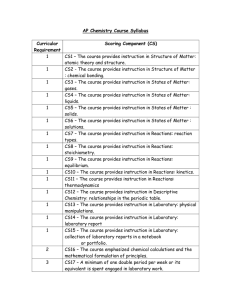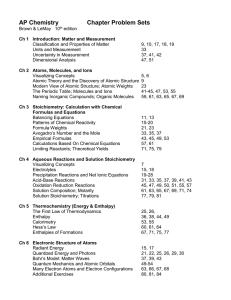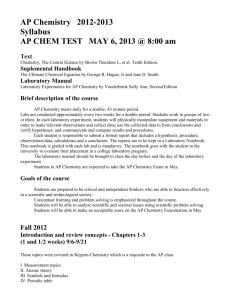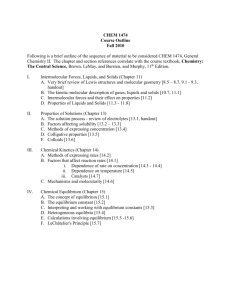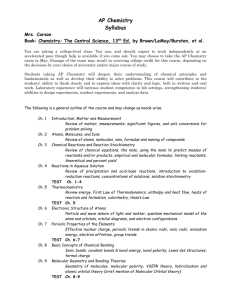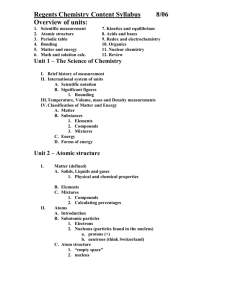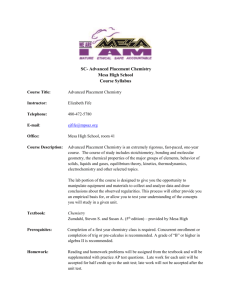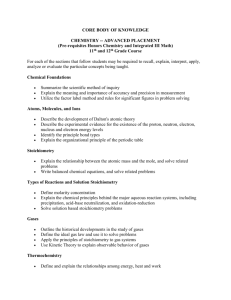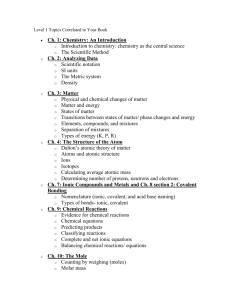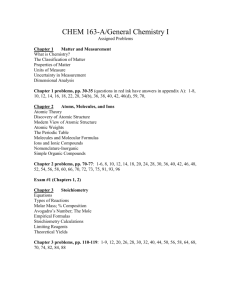AP course schedule
advertisement
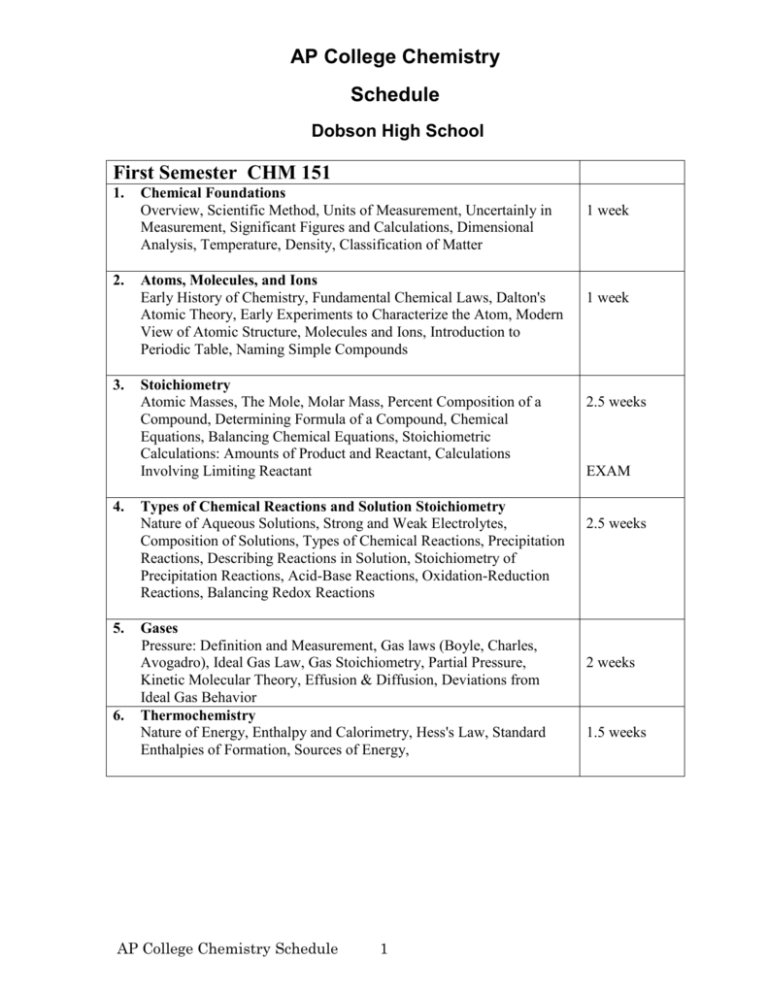
AP College Chemistry Schedule Dobson High School First Semester CHM 151 1. 2. 3. 4. 5. 6. Chemical Foundations Overview, Scientific Method, Units of Measurement, Uncertainly in Measurement, Significant Figures and Calculations, Dimensional Analysis, Temperature, Density, Classification of Matter Atoms, Molecules, and Ions Early History of Chemistry, Fundamental Chemical Laws, Dalton's Atomic Theory, Early Experiments to Characterize the Atom, Modern View of Atomic Structure, Molecules and Ions, Introduction to Periodic Table, Naming Simple Compounds Stoichiometry Atomic Masses, The Mole, Molar Mass, Percent Composition of a Compound, Determining Formula of a Compound, Chemical Equations, Balancing Chemical Equations, Stoichiometric Calculations: Amounts of Product and Reactant, Calculations Involving Limiting Reactant Types of Chemical Reactions and Solution Stoichiometry Nature of Aqueous Solutions, Strong and Weak Electrolytes, Composition of Solutions, Types of Chemical Reactions, Precipitation Reactions, Describing Reactions in Solution, Stoichiometry of Precipitation Reactions, Acid-Base Reactions, Oxidation-Reduction Reactions, Balancing Redox Reactions Gases Pressure: Definition and Measurement, Gas laws (Boyle, Charles, Avogadro), Ideal Gas Law, Gas Stoichiometry, Partial Pressure, Kinetic Molecular Theory, Effusion & Diffusion, Deviations from Ideal Gas Behavior Thermochemistry Nature of Energy, Enthalpy and Calorimetry, Hess's Law, Standard Enthalpies of Formation, Sources of Energy, AP College Chemistry Schedule 1 1 week 1 week 2.5 weeks EXAM 2.5 weeks 2 weeks 1.5 weeks 7. Atomic Structure and Periodicity Electromagnetic Radiation, Nature of Matter, Atomic Spectrum of Hydrogen, Bohr Model, Quantum Mechanical Model, Quantum Numbers, Orbital Shapes and Energies, Electron Spin and Pauli Principle, Polyelectronic Atoms, History of Periodic Table, Aufbau Principle and Periodic Table, Periodic Trends and Atomic Properties, Properties of a Group: The Alkali Metals 2.5 weeks EXAM 8. Bonding: General Concepts Types of Chemical Bonds, Electronegativity, Bond Polarity and Dipole 2 weeks Moments, Ions:Electron Configurations and Sizes, Formation of Binary Ionic Compounds, Partial Ionic Character of Covalent Bonds, Covalent Chemical Bond: A Model, Covalent Bond Energies and Chemical Reactions, The Localized Electron Bonding Model, Lewis Structures, Exceptions to Octet Rule, Resonance, Molecular Structure: The VSEPR Model 9. Covalent Bonding: Orbitals Hybridization and the Localized, Electron Model, Molecular Orbital Model, Bonding in Homonuclear Diatomic Molecules, Bonding in Heteronuclear Diatomic Molecules, Combining the Localized Electron and Molecular Orbital Models 1 week EXAM End of First Semester FINAL EXAM AP College Chemistry Schedule 2 Second Semester CHM 152 10. Liquids and Solids Intermolecular Forces, The Liquid State, An Introduction to Structures and Types of Solids, Structure and Bonding in Metals, Carbon and Silicon: Network Atomic Solids, Molecular Solids, Ionic Solids, Vapor Pressure and Changes of State, Phase Diagrams 11. Properties of Solutions Solution Composition, Energies of Solution Formation, Factors Affecting Solubility, Vapor Pressures of Solutions, Boiling Point Elevation and Freezing Point Depression, Osmotic Pressure, Colligative Properties of Electrolyte Solutions, Colloids 12. Chemical Kinetics Reaction Rates, Rate Laws: An Introduction, Determining the Form of the Rate Law, The Integrated Rate Law, Rate Laws: A Summary, Reaction Mechanisms, A Model for Chemical Kinetics, Catalysis 2.5 weeks 2 weeks 2 weeks EXAM 13. Chemical Equilibrium The Equilibrium Condition, The Equilibrium Constant, Equilibrium Expressions Involving Pressure, Heterogeneous Equilibria, Applications of the Equilibrium Constant, Solving Equilibrium Problems, LeChatelier's Principle 14. Acids and Bases Nature of Acids and Bases, Acid Strength, The pH Scale, Calculating the pH of Strong Acid Solutions, Calculating the pH of Weak Acid Solutions, Bases, Polyprotic Acids, Acid-Base Properties of Salts, Effect of Structure on Acid-Base Properties, Acid-Base Properties of Oxides, Lewis Acid-Base Model AP College Chemistry Schedule 3 1 week 2.5 weeks EXAM 15. Applications of Aqueous Equilibria Solutions of Acids or Bases Containing a Common Ion, Buffered Solutions, Buffer Capacity, Titrations and pH Curves Acid-Base Equilibria, Solubility Equilibria and the Solubility Product, Precipitation and Qualitative Analysis, Equilibria Involving Complex Ions 16. Spontaneity, Entropy, and Free Energy Spontaneous Processes and Energy, Entropy and the Second Law of Thermodynamics, The Effect of Temperature on Spontaneity, Free Energy, Entropy Changes in Chemical Reactions, Free Energy and Chemical Reactions, The Dependence of Free Energy on Pressure, Free Energy and Equilibrium, Free Energy and Work 17. Electrochemistry Galvanic Cells, Standard Reduction Potentials, Cell Potential, Electrical Work, and Free Energy, Dependence of Cell Potential on Concentration, Batteries, Corrosion, Electrolysis, Commercial Electrolytic Processes. 3 weeks EXAM 2 weeks 2 weeks EXAM 21. The Nucleus: A Chemist's View Nuclear Stability and, Radioactive Decay, Kinetics of Radioactive Decay, Nuclear Transformations, Detection and Uses of Radioactivity, Thermodynamic Stability of the Nucleus, Nuclear Fission and Nuclear Fusion, Effects of Radiation FINAL EXAM End of Second Semester AP College Chemistry Schedule 1 week 4
